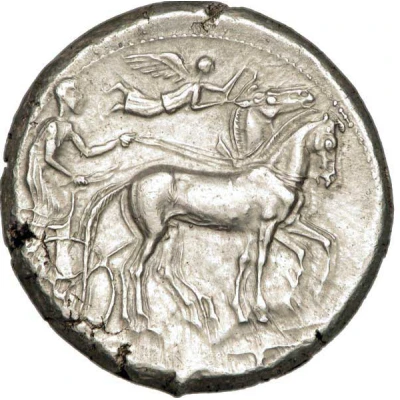


Tetradrachm - Gelon I 485 BC
485 BC year| Silver | 16.99 g | 23 mm |
| Issuer | Syracuse (Sicily) |
|---|---|
| Tyrant | Gelon I (Γέλων) (485 BC - 478 BC) |
| Type | Standard circulation coin |
| Year | 485 BC |
| Value | Tetradrachm (20) |
| Currency | Litra |
| Composition | Silver |
| Weight | 16.99 g |
| Diameter | 23 mm |
| Shape | Round (irregular) |
| Technique | Hammered, Incuse |
| Orientation | Medal alignment ↑↑ |
| Demonetized | Yes |
| Updated | 2024-10-10 |
| Numista | N#407717 |
|---|---|
| Rarity index | 100% |
Reverse
Two large grains of barley; all within a deep incuse square.
Script: Greek
Lettering: ΣVRA
Comment
C. Arnold-Biucchi, and A.-P. C. Weiss, “The River God Alpheios on the First Tetradrachm Issue of Gelon at Syracuse,” QT XXXVI (2007), pp. 59-74, pl. I, 1-1a.
Unique.
From CNG :
This coin was the subject of an important article by Arnold-Biucchi and Weiss (cited above) in which they concluded that the river god had to be Alpheios: the river god from Epirus who dived into the sea to follow Arethusa to the spring on the island of Ortygia, where Syracuse was founded. They also pointed out that epigraphically and stylistically the coin must have been issued after Boehringer’s Group I, Series II had ended, since all of those coins had four letter inscriptions using three-bar sigmas (ϟVRΑ). This piece has a four letter inscription as well, but with the more ‘modern’ four-bar sigma (ΣVRΑ); however, this only appeared on a single die, V 25, which was used for all of the small group of coins that make up B. Group II, series 3 (B. 34-37). There, however, it was partnered with the complete city name on the reverse (Group II, series 3); beginning with Group II, series 4 the four letter inscription disappears, with only the full name on the reverse. Thus our coin, with only a single inscription, must come before Group II, 3.
This internal chronology enables us to show that this coin must have been struck c. 485 when Gelon, the powerful tyrant of Gela, captured Syracuse. The head of Alpheios is very close to the head of the river god Gelas who appears on Gela’s issues and it would seem that Gelon wanted to mark his control over Syracuse by a spectacular coinage that was completely different from what had been struck before. Clearly, the Syracusans did not approve and must have insisted on a coinage that more clearly reflected the status of their own powerful city. Thus the change to a revised version of their traditional tetradrachm coinage.
Interesting fact
One interesting fact about the Tetradrachm - Gelon I (485 BC) from Syracuse (Sicily) is that it features a unique combination of Greek and Sicilian elements on its design. The obverse side of the coin depicts the head of the Greek goddess Athena, while the reverse side features a quadriga (a four-horse chariot) driven by the mythical creature, the Hippocampus. This blending of cultural influences reflects the rich history and cultural exchange that occurred in Sicily during the ancient Greek period.



